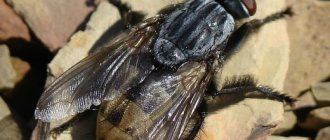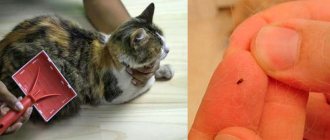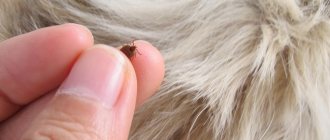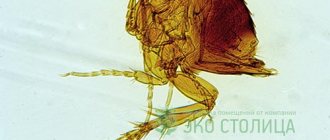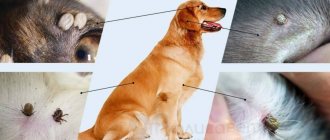Worms are parasitic worms that live, feed and reproduce in the donor's body. They enter the digestive tract, spread throughout the organs and do not manifest themselves for years. But all this time, great harm is done to the dog’s health. And communication with a pet can cause infection to humans and other pets.
Ways of infection with worms
In the vast majority of cases, a dog becomes infected with worms by ingesting their eggs.
But there is another way of infection - transmissible, through the bites of blood-sucking insects. In addition, the parasite can enter through lesions on the animal's skin. Newborn puppies easily become infected from their mother, who is a carrier of helminthic infestation. Helminth eggs can enter the pet’s body if:
- the owner does not pay enough attention to the sanitary and hygienic side of the life of his four-legged friend;
- the dog is not given preventive deworming;
- the pet eats raw meat and fish;
- the dog often walks unaccompanied (dubious “acquaintances” are possible, drinking from puddles, eating various leftovers, and so on);
- There are other animals living in the apartment that have worms.
Under other favorable conditions, a pet can become infected even at home by sniffing the shoes of an owner who comes in from the street.
Note: no dog is immune from worms, but the risk group includes animals with weakened immune systems, puppies, hunting and yard dogs.
Prevention of helminth infection – what should you pay special attention to?
The real danger of dirofilariasis makes the issue of preventing this disease particularly relevant. Unfortunately, there is no remedy that would help completely eliminate the risk of helminth infection. All you can do is ensure that your dog is protected from mosquito bites and other insects that may act as carriers. Particular attention should be paid to this during the high season - from May to September. To treat the animal, you can use different sprays, drops and even special collars. We recommend consulting with a veterinarian - he will tell you which method of prevention will be most effective in your case.
Why are helminths dangerous for dogs?
If left untreated, worms in dogs can lead to serious consequences over time, including:
- weakened immunity and retarded growth and development due to insufficient supply of nutrients to the animal’s body;
- mental exhaustion of the dog due to constant itching, pain, discomfort;
- the addition of infection against the background of a decrease in protective forces, the development of numerous diseases;
- serious intoxication of the pet’s body with toxic metabolic products of parasites, the development of allergic reactions.
Helminths lead to diseases of the liver, brain, heart, lungs and other organs. Ignoring the symptoms of worms in a dog is fraught with the development of jaundice, heart attack, epilepsy, intestinal obstruction, cerebral hemorrhage, loss of vision and other consequences, including death.
Important: according to statistics, more than 60% of domestic dogs are infested with helminths. At the same time, infected pets look clinically healthy, so owners do not always suspect that their beloved animal is sick.
Intestinal parasites in dogs
Treatment
The first treatment of puppies for any type of worms should be carried out at the age of three weeks. Babies, pregnant and lactating bitches, and elderly pets are extremely sensitive to toxins that are released after the parasites die. Therefore, to treat them, it is necessary to use special anti-worm medications for dogs. In addition, veterinarians recommend giving them a spoonful of Vaseline oil to quickly remove decay products.
Pills
The anthelmintic in tablet form is crushed and added to the pet’s food. After two weeks, the treatment is repeated. In this way, larvae and young worms are destroyed, which were protected by the egg shell at the time of the first administration of the medicine. Quality drugs include Milbemax, Drontsit, Alben, Bicheldon, Brovanol.
Suspensions
The advantage of this form of anthelmintic drug is the ease of measuring the dosage. In addition, suspensions often have a pleasant smell and taste for the pet. To treat worms, you need to take the suspension into a syringe, remove the needle and squeeze the medicine into the animal’s mouth. Veterinarians recommend the drugs Helmintal, Dironet, Dironet Junior, Dirofen, Prazitel.
Drops on the withers
Liquid deworming medications for dogs perform several functions. They destroy helminths in the animal’s body and ectoparasites on its fur. Drops are applied to the area between the shoulder blades so that the dog cannot lick off the medicine. The liquid is quickly absorbed through the pores of the skin into the bloodstream and destroys parasites. Quality products – Prazicide Complex, Inspector, Lawyer, Stronghold, Helmintal.
Traditional medicine
Folk remedies for worms for dogs only help get rid of intestinal parasites. Additionally, it is very difficult to calculate the dosage of a home remedy. A low concentration of the main substance will not be able to destroy helminths, but too high will harm the health of the pet. Medicinal plants with similar effects include tansy, celandine, wormwood, garlic, and pumpkin seeds.
Symptoms of worms in dogs
At the beginning of the disease, it is quite difficult to determine the presence of worms in a dog. Signs of helminthiasis begin to appear when the parasites have multiplied and caused significant harm to the body. In this case, the owner can find in the dog’s feces both the worms themselves, which have come out of the intestines, and their eggs in the form of tiny grains.
However, it is not always possible to see worms or their eggs with the naked eye. It is possible to suspect helminthiasis in a pet based on the following symptoms:
- the dog loses weight with an excellent appetite;
- the fur has become dull;
- the animal licks the anus and/or rubs its anus on the floor;
- the pet is breathing heavily and has a cough;
- bloated belly (especially in puppyhood);
- difficult bowel movements alternating with diarrhea;
- lack of appetite;
- vomit;
- skin rashes.
Important: if you notice such symptoms, you should first consult a veterinarian. The same signs may indicate the development of other disorders, so you cannot independently administer medications for parasites based only on the listed manifestations.
Diagnosis of helminthiases
If you suspect helminthiasis, you should contact a veterinary clinic for diagnostic measures. Diagnosis of worms in dogs consists of laboratory testing of blood and feces. Analyzes make it possible not only to identify the presence of parasites, but also to determine their species.
Many owners believe that to diagnose helminthiasis it is enough to test their pet’s feces. However, some worms that live in the heart or lungs can only be detected by testing the animal's blood. Preference is given to enzyme-linked immunosorbent assay (ELISA) or polymerase chain reaction (PCR). These methods are considered the most informative.
If a pulmonary or cardiac form of helminthiasis is suspected, the doctor may prescribe an X-ray examination and/or ultrasound of the heart.
Attention: even if the owner knows what a particular parasite looks like, if you find worms in the dog’s feces, you should definitely submit stool for diagnosis. It is quite possible that other helminths will be present in the animal’s body.
Forms of dirofilariasis
The following forms of dirofilariasis are known:
- Heart shape . Roundworms (dirofilaria) affect the right side of the heart and large blood vessels - the aorta, pulmonary artery. The cardiac form of dirofilariasis is most often diagnosed in dogs.
- Subcutaneous form . Adults of this species are localized in the subcutaneous tissue and muscles, causing severe itching and skin damage (ulceration, inflammation, redness, etc.). Diagnosed less frequently than the cardiac form.
- Eye shape . It is extremely rare. Accompanied by inflammatory eye diseases. Neoplasms are possible.
Be careful - accidental infection of a person with dirofilariasis is possible.
How to properly deworm dogs
In order to completely and without complications expel worms from a domestic dog, you need to follow certain rules.
- Get tested first at a veterinary clinic.
- Carefully read the instructions for the deworming medication.
- As a rule, the medicine is given in the morning and on an empty stomach to avoid vomiting (unless otherwise recommended).
- Before taking the product, your pet must be treated against insects (several days before).
- In the process of destroying parasites, the dog must drink a lot - make sure there is clean water in the bowl.
- During treatment, it is advisable to protect the liver from toxins released by dying worms. You need to ask your veterinarian in advance what medications can be used.
- Be sure to make sure that the animal has a bowel movement in the next few hours. Otherwise, you need to give your pet a laxative.
- Be sure to re-treat after 10-14 days.
During deworming, you need to carefully monitor the dog's condition. If there is a significant accumulation of parasites during their mass death, the animal may experience severe intoxication: vomiting, clouding of consciousness, convulsions. This condition requires treatment in a clinic (intravenous administration of drugs) under the supervision of a specialist.
Preventive actions
Unfortunately, it is not possible to completely prevent a dog from becoming infected with worms. However, the risk of helminthiasis can be significantly reduced with the help of basic preventive measures.
- Deworm your pet in a timely manner, observing the timing and dosage.
- Periodically test feces for helminthiasis, even in the absence of corresponding symptoms.
- Eliminate raw fish and tripe from your diet. Process raw meat with boiling water.
- Do not allow your dog to drink from puddles or open water or pick up pieces of food on the street.
- Promptly identify and destroy blood-sucking insects. Treat the animal with products for external use.
- Avoid unnecessary “acquaintances” with your pet.
- Regularly wash your dog's bedding and water and food bowls.
Is it possible to get worms from a dog?
Humans and other pets can easily become infected with certain types of worms, such as echinococcosis, from dogs. Helminth eggs enter the body after communicating with the dog from unwashed hands, from under the nails. They can enter through the mucous membranes, for example, if a person rubs their nose or sneezes.
To avoid infection, you need to avoid kissing your pet, wash your hands with soap every time after communication, and limit its location in the apartment, not allowing it on your bed or at the table. In addition, frequent wet cleaning using disinfectants will help reduce the likelihood of infection.
Zoonotic parasites
Pet owners are interested in which dog parasites are transmitted to humans. A large number of helminth eggs accumulate at the anus.
By licking itself, the animal transfers them to other areas of the body. Close contact with a dog can lead to infection. Most often, tapeworms and roundworms migrate from dogs.
The tick is also dangerous for humans, as it easily spreads to the epidermis, clothing and bedding of a person upon contact. When petting your dog, you can become infected with scabies, ringworm and dermatophytosis (fungal infections).
When to give deworming medicine to your dog
Dogs are first dewormed at about 3 weeks of age as a puppy. Next, medicine for worms is given depending on vaccination - 2-3 weeks before vaccination, and then every six months. As they grow older, it is recommended to worm dogs once every 3-6 months, and also 2-3 weeks before vaccination. Female dogs need to be dewormed before a planned mating, as well as after estrus. Pregnant animals are not given anthelmintic drugs.
It should be taken into account that in order to completely destroy worms in dogs, the medicine should be given twice, with a break of 10-14 days. This will allow you to destroy adult parasites and those that emerge from the larvae during this time.
Danger to humans
A dog or puppy with worms, when interacting with a person, can infect him with helminthiasis. The larvae and eggs of parasites leave the animal's body in the feces. They can attach to the pet's fur, bedding or toys, and then end up in the owner's hands.
Due to the difference in body temperature, not all dog worms can live in the human body. But some of them can cause dangerous diseases.
- Toxocara canis. The larvae migrate through the human circulatory system, settling in various organs. As a result, ocular or visceral toxocariasis develops. It affects the lungs, liver, eyes, and central nervous system.
- Echinococcus granulosus. The larvae of this helminth are extremely dangerous for the human body, although they cannot develop in it. They migrate throughout the body and settle in the lungs, forming a cyst. The neoplasm causes coughing and chest pain.
- Echinococcus multilocularis. The larvae of this tapeworm settle in the human liver and also form a cyst. When a secondary infection occurs, jaundice, abscess, and cirrhosis of the liver develop.
- Coenurus cerebralis. The larvae of such worms look like a water bubble. They settle in the area of the spinal cord or brain. Depending on the location of the lesion, a person suffers from migraines, seizures, and decreased vision.
- Dipylidium caninum. The tapeworm takes root in the human intestine, develops, grows, and reproduces. As a result, the patient suffers from diarrhea, skin rash, and abdominal pain.
Timely deworming and proper personal hygiene will help avoid the development of these diseases.
How to collect dog stool for analysis
To do a stool test for the presence of worms, simply take a small amount of dog feces and take it to the laboratory. Feces can be placed in a container (special containers are sold in regular pharmacies) or, as a last resort, in a plastic bag. If it is not possible to transport it immediately, it is allowed to store the material for 1-2 days at a temperature not exceeding 30 °C (best - 3-10 °C). To detect worm larvae, it is not necessary that the feces be fresh.
Sometimes it is necessary to do a series of sequential stool tests for worms. In this case, feces should be collected after each bowel movement of the dog. Serial diagnostics increases the reliability of the results obtained.
Morphological features
It all starts with the appearance of small swellings and thickening on the surface of the skin. At first, their size does not exceed 1x1 cm, but within a few weeks the area of the lesions increases two to three times. Most often, these tumors are found on the lower surface of the abdominal wall, closer to the genital area. Soon the seals soften somewhat, becoming similar in consistency to cysts . When they were surgically removed, the inside of the cysts was separated from the “main” tissue by a demarcation line of inflammation (but not always). In addition, a worm is found inside the tumors. The length of subcutaneous parasites does not exceed 12 cm , their body is thin, grayish-white in color.


